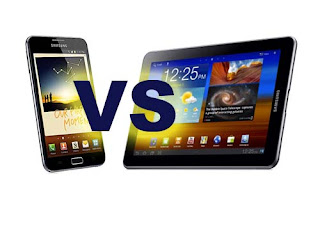Form
The Galaxy Tab has two faces really, on the screen side you’ve got a stylish shiny black bezel which is evenly spaced round the whole display for a very clean look.
Turn the device over and you’re presented with a much more raw looking surface of brushed silver-coloured aluminium.
Either way you flip it there’s not a lot of noise or disruption going on, Samsung has kept visual clutter to a minimum and the shape is appealing to the eye as its corners are neither too soft nor too angular.
The Galaxy Note immediately looks good thanks to a super thin bezel along two of its edges – a design feature which in our view makes for instant visual flair when applied to any gadget with a screen.
The back panel is particularly nice thanks to a slight curvature and a textured surface, apart from this just like the rest of Samsung’s designs it is quite minimalist, which is a look that works well here.
We think both devices look equally good.
Winner - Draw
DisplayBoth devices feature Samsung’s own Super AMOLED technology for their displays, although it should be noted the Galaxy Tab 7.7 uses the upgraded Super AMOLED Plus version while the Galaxy Note is on the brand new Super AMOLED HD variant.
The Galaxy Tab 7.7 has a cunning clue in its name regarding the size of its capacitive touchscreen, with a 7.7-inch display and an 800x1280 pixel resolution, the Galaxy Tab sports a pixel density of 196 pixels-per-inch (ppi).
It’s loaded with Samsung’s TouchWiz UX user interface (UI), supports multi-touch and is fitted with an accelerometer and gyro sensor for screen rotation.
Samsung’s rather large smartphone, the Galaxy Note, has a slightly smaller capacitive touchscreen at 5.3-inches, made from Gorilla Glass and with multi-touch support.
A modified TouchWiz 4.0 UI is pre-installed and allows for things like split screen menus and app screens, as well as supporting the innovative S Pen stylus included with the device.
It also has accelerometer and gyro sensors built in.
Screen resolution is the same as the larger Galaxy Tab 7.7, but the smaller size means a higher pixel density of 285ppi.
The Galaxy Note’s display is our first choice here thanks to the unique S Pen stylus support and interface tweaks which really make the best use of the vast screen space.
Not only that, but it also has a much higher pixel density and the added bonus of superior Super AMOLED HD.
Winner – Samsung Galaxy Note
StorageSamsung’s 7.7-inch tablet has three internal storage options for 16GB, 32GB and 64GB of space, each with 1GB of RAM and microSD support up to 32GB.
The Galaxy Note is similar, the only difference is it doesn’t have that top-end 64GB onboard storage option.
The Galaxy Tab 7.7 wins this round by having more storage to play with.
Winner – Samsung Galaxy Tab 7.7
Processor setups on these devices are identical – each has a 1.4GHz dual core ARM Cortex A9 processor on the Exynos chipset and running a Mali-400MP graphics processing unit (GPU).
These are both Android devices, the Samsung Galaxy Note runs Gingerbread 2.3 while the larger Galaxy Tab 7.7 uses the tablet-specific 3.2 Honeycomb build.
Tablets are often slightly lacking in the camera department and sadly this is also the case with the Samsung Galaxy Tab 7.7.
We’d say overall these are fairly evenly matched devices, particularly when you boil it down to the bare bones with things like the processor setup.







 10:59 AM
10:59 AM
 Simranpal SIngh
Simranpal SIngh






















